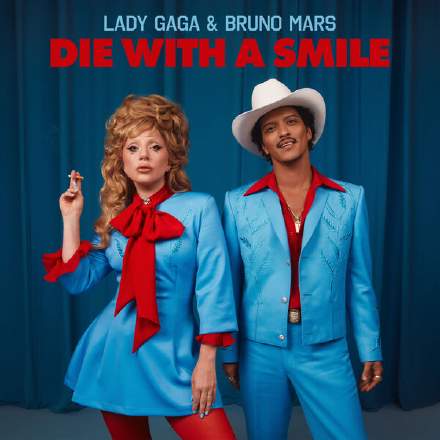
Now, I don’t know about you, but the onset of this song’s prechoruses feels like a bit of a let-down. Yes, the arrangement tries to fabricate a sense of musical arrival by adding piano and bass parts on the first occasion (at 0:27), and by adding piano and synth-pad parts second time around (at 1:45), but fundamentally I think the prechorus’s impact is being undermined by its choice of opening chord.
You see, moving from one chord to a different chord carries its own inherent musical emphasis, so it usually feels most natural to us if the rhythmic placement of these chord changes (or ‘harmonic rhythm’) lines up with other stress patterns in the music. Indeed, one of the less well-known ‘rules’ of traditional harmonic theory is that you should try to change chord when moving from a weak beat to a strong beat – thereby syncing up the stress patterns of the harmonic rhythm with the musical metre’s stress pattern. This is why you’ll find lots of situations in pop songs where a chord is played on a strong beat (eg. beats one and three in a four/four time signature) and then sustained over onto the following weak beat (eg. beats two and four in four/four), whereas it’s much rarer to hear a new chord arriving on a weak beat and then sustaining onto the following strong beat.
Moreover, this principle operates on a structural level too, where chord changes tend to feel most natural when moving from a weak bar to a strong bar within the prevailing phrase structure, and that’s where I think the prechorus of ‘Die With A Smile’ comes unstuck. While the song starts off by swapping regularly between Amaj7 and Dmaj7 chords on the (more strongly stressed) first and third bars of each four-bar musical section, as you’d naturally expect, when we get to the (strong) first bar of the prechorus, the chord doesn’t change, maintaining the same Dmaj7 harmony we heard in the (weak) fourth bar of the verse, and thereby robbing some musical emphasis from the beginning of that section.
On the plus side, though, this song does provide a great illustration of how reverb automation can be used for section differentiation. If you listen to the first chorus (0:45-1:17), there’s a long-tail reverb on the snare drum, although it’s dull-sounding enough that the rest of the arrangement masks it a lot of the time – soloing the mix’s Sides channel reveals it much more clearly. However, when we hit the second verse, this reverb is suddenly removed, which subtly (but profoundly) reduces the sense of subjective ‘size’, making the presentation feel more intimate at that point. Then the reverb begins to creep back in for the second prechorus, before returning full-force for the rest of the song. What’s particularly interesting to me in this scenario, though, is that the reverb character is fundamentally fairly unnatural-sounding, and in any case starkly in contrast to the snare sound itself, which I suspect is why I don’t get a sense that the chorus snare is merging very much with its reverb, which means it doesn’t appreciably recede in the mix’s front-back depth perspective as a result.

I’ll confess right upfront that I always disliked this tooth-rottingly syrupy song, with its relentless D-Bm-Em-A harmonic loop, plodding groove, and plasticky ’80s synth textures. Given its extraordinary longevity, though, I recently felt duty-bound to have a closer analytical look at it, and I have to say that I now hold it in a lot higher esteem. Many musicians worry that analysis will ‘kill the magic’ of their favourite music, but personally I think it’s the other way round – not only does analysing songs I already love deepen my appreciation of them, but I also find that analysis of music that doesn’t immediately appeal to me often uncovers qualities that I initially overlooked.
So what was it that I found in this case? Well, one of the first things I noticed was the unusual distribution of the programmed drum fills, where the same pattern of fills almost never appears in any similar song section. On further investigation, it seems as if George Michael (who not only wrote this song, but also apparently created and performed the entire arrangement himself) built this production around a 20-bar LinnDrum sequence constructed out of eight different two-bar programmed patterns chained in the following order: 1-2-3-4-5-6-5-7-1-8. If I now superimpose the song structure over this repeating chain of drum patterns, you’ll see that the song’s eight-bar musical sections don’t fit neatly into the 20-bar loop length…
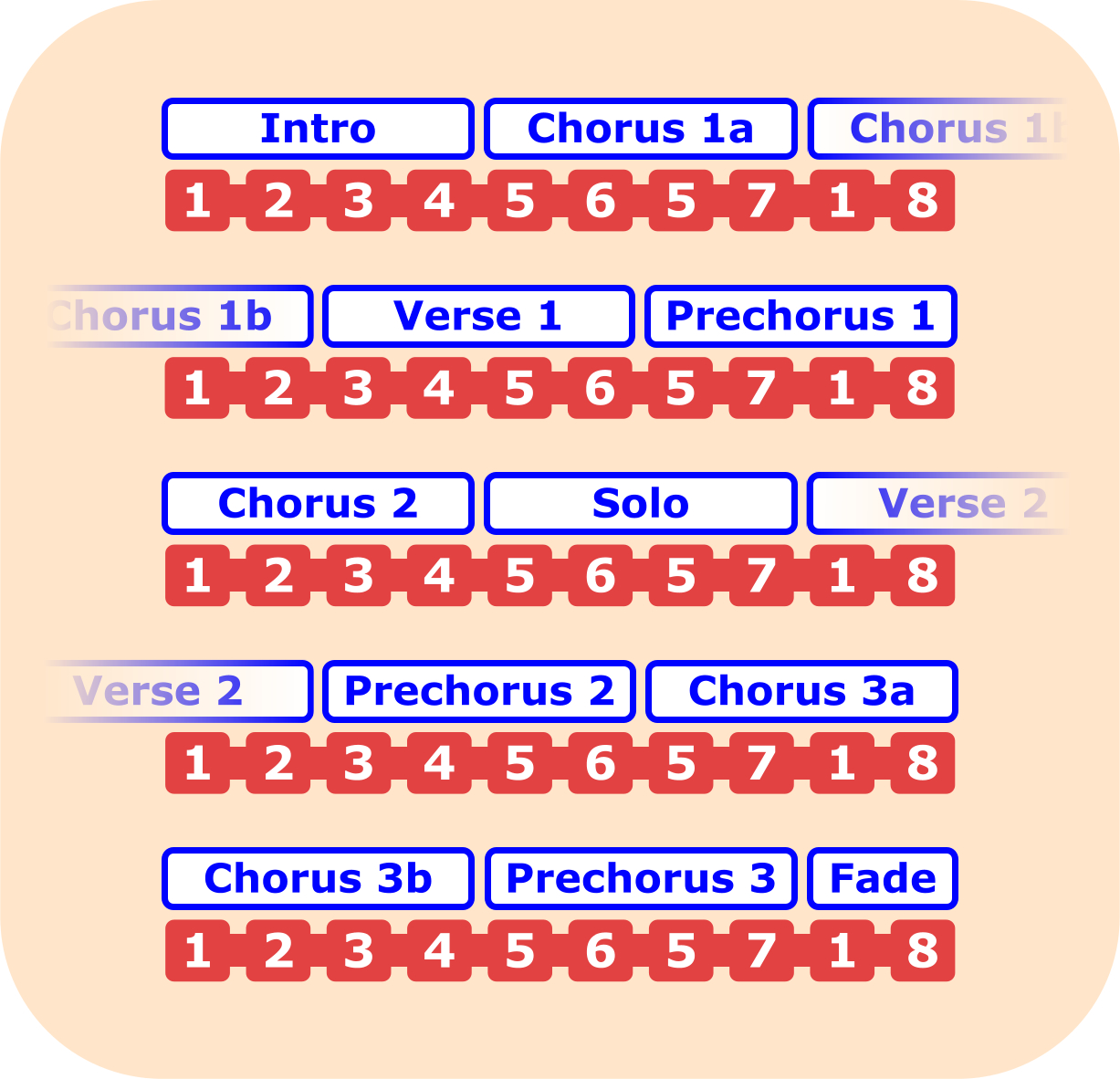
…and if I now rearrange that picture to line up all the similar song sections vertically, it’s clear to see that this almost completely avoids any similar song section from having an identical pattern of fills.
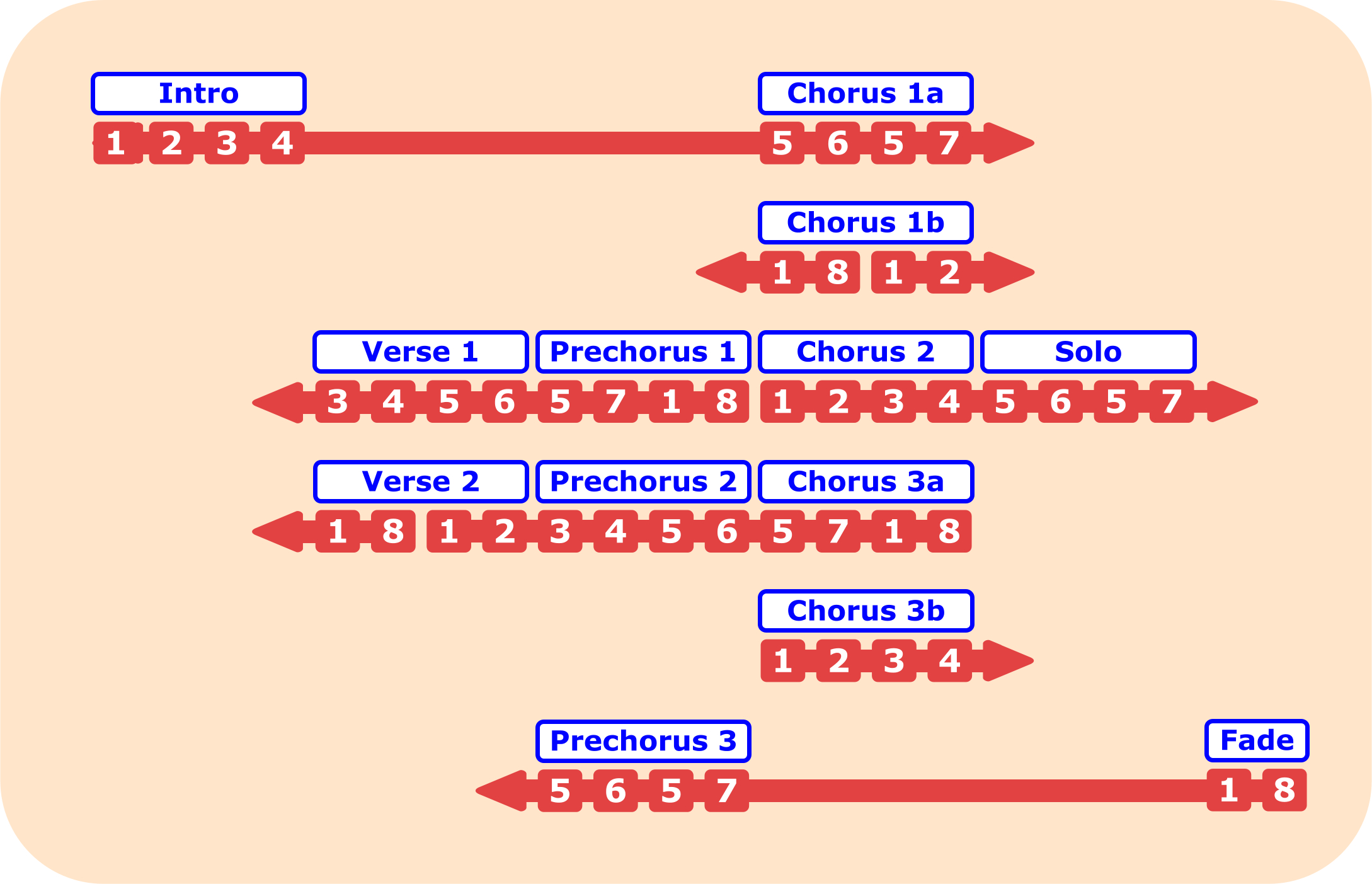
The sharper-eyed amongst you may, however, have spotted that my song structure here is actually missing a couple of sections, namely the Solo after Chorus 1b and the repetition of Chorus 2. Well, it turns out that both of these sections just repeat the drum patterns of the section before them, like this…
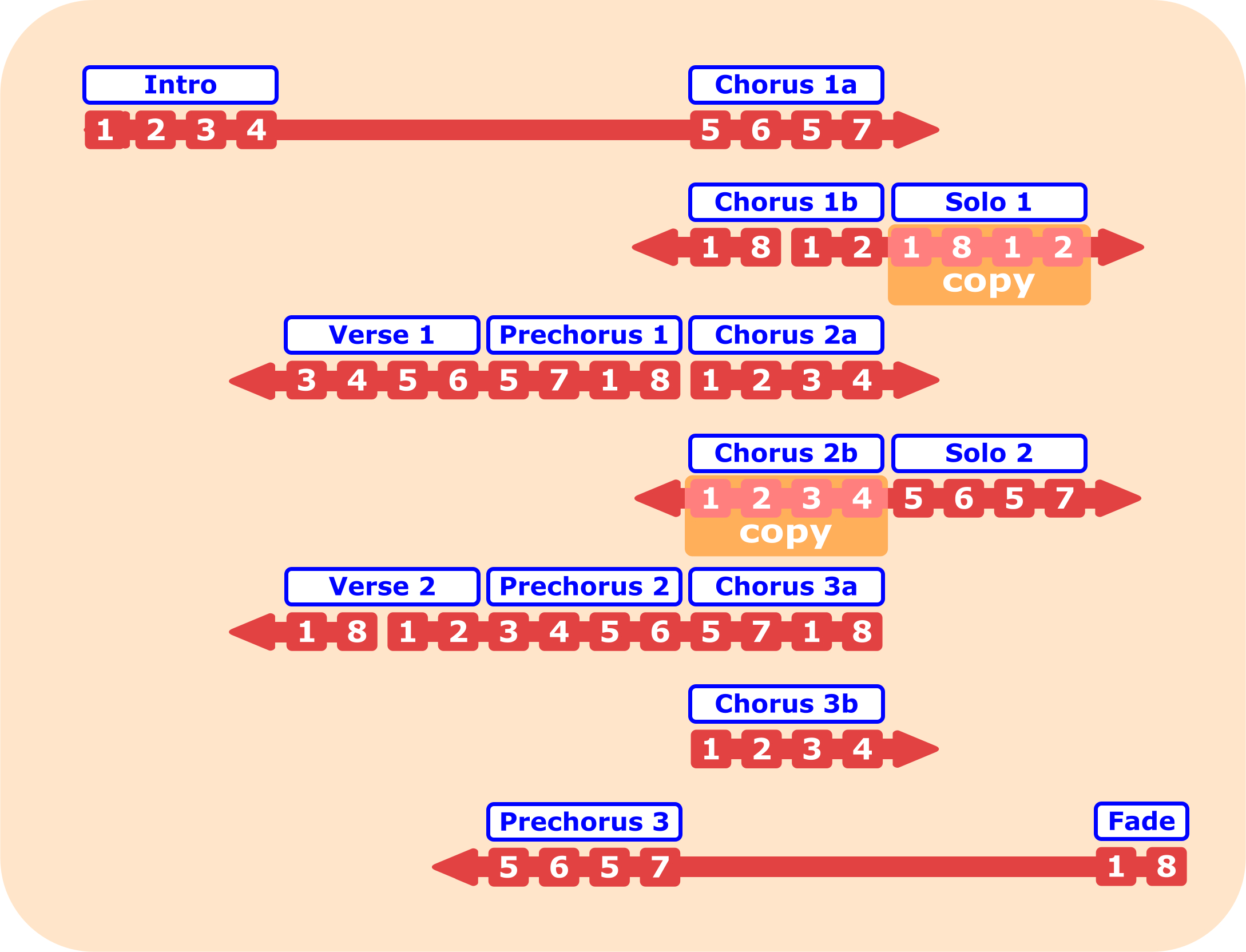
…which leads me to suspect that they were probably added midway through the production process after the LinnDrum had been committed to tape, by editing the multitrack. And I can see the reasoning too, because those copied additions give the main body of the song a more regular structure, comprising two iterations of Solo-Verse-Prechorus-Chorus-Chorus.
But it’s not just the drums that vary between song sections, because the bass part is similarly nuanced. Despite the repeating chord progression, every single eight-bar section of the song delivers a slightly different bass line, with just one notable exception: Chorus 2b, where the bass appears to have been copied from Chorus 2a alongside the drums, suggesting to me that this tape edit was done later in the production process than the edit that created Solo 1. The fact that George Michael put such effort into adding musical variety to this arrangement, a pale imitation of which could easily have been thrown together in a fraction of the time via lazy copy/paste repetition, speaks volumes to me about his work ethic. Plus, assuming my hunches about the tape editing are correct, I think it’s also fascinating to get a glimpse into the creative process from which this song’s final structure developed.
The arrangement overall is very smartly managed too, building up progressively from each of the two verse sections by virtue of progressively richer/brighter synth layers and vocal doubletracks/harmonies. But my favourite aspect of the arrangement is (to formulate a sentence that I never, ever thought I’d find myself writing) the sleighbells! You see, they don’t just jingle all the way, whatever you think you may remember about this song – they actually only appear during the Solo sections. This is genius, because if there had been sleighbells constantly battling against the lead vocal in the upper spectrum, there’s no way the mix engineer would have been able to bring out the characteristic breathiness of George Michael’s voice as effectively. In fact, I might even hazard a guess that one reason for editing in the extra Solo section near the start of the song might have been to provide the sleighbells an earlier opportunity to signpost the song’s seasonal nature without conflicting with the voice.
All these fun things notwithstanding, there is one aspect of this song that does leave me scratching my head. When I lined up the single version against the longer ‘Pudding Mix’ version on Wham’s contemporaneous Music From The Edge Of Heaven album, it immediately became apparent that they were drifting out of sync with each other. Tempo-mapping them both revealed that the album version remains at a pretty regular tempo throughout the song, whereas the single version speeds up by around 1bpm during Solo 1 (0:55-1:11), and then very gradually slows down (by roughly 0.5bpm) over the next 32 bars before stabilising from Solo 2 onwards. Given that the LinnDrum was one of the earliest commercially available drum machines, without the benefit of today’s sophisticated tempo-mapping facilities, the simplest method of implementing such tempo changes would have been to tweak the final tape’s varispeed control in real time during the mastering process – a speculation that’s corroborated by the overall pitch rise (of roughly 15 cents) you can hear if you compare the first and second choruses side by side. Chorus 1: play_arrow | get_app Chorus 2: play_arrow | get_app
Regardless of how the single’s tempo profile was created, though, it does seem rather odd to me. If the idea was to subliminally give the verse a bit more pep, then why not do a similar move during Solo 2 as well? Or if you’re not going to do that, then why slowly reduce the tempo after Solo 1 at all? After all, if the extra pace helped the first verse, shouldn’t it help the rest of the song too? I can’t imagine that any concerns about the single’s overall duration are pertinent here either, because comparing the single with the album shows that the tempo changes make less than two seconds’ difference to the song’s running time. In fact, even if the higher tempo at the end of Solo 1 had been maintained for the rest of the song, that still wouldn’t have shortened the overall duration by more than about three seconds.
It’s a Christmas mystery…

As the decades-long Loudness War begins to abate, there are many reasons to applaud artists who decide to master their songs at lower integrated loudness levels in order bring greater dynamic range to their music. This Gigi Perez song, for instance, boasts a loudness range of more than 12dB, well over twice that exhibited by many recent high-profile chart releases – for comparison, none of Beyoncé’s ‘Texas Hold ‘Em’, Sabrina Carpenter’s 'Please Please Please', Boy Genius’s 'Not Strong Enough', or The Beatles’s 'Now And Then' manage a loudness range of even 6dB.
What people don’t often talk about, however, is that by preventing producers from cheaply conjuring musical momentum/energy out of thin air via simple volume increases, the Loudness Wars effectively put more emphasis on delivering a sense of build-up and intensity via other means – more compelling performances, say, or more creative songwriting and arrangement. And this is where ‘Sailor Song’ falls down for me, because it feels like it’s using its dynamic range as a sticking plaster, lending a superficial veneer of excitement to a production that otherwise generates precious little of its own. The harmony certainly provides no musical impetus, ploughing the same three-chord E-G#m-B furrow for basically the whole song. The acoustic guitars grimly beat their 3/8-3/8-2/8 strumming pattern into submission throughout too, a monotony that’s hardly alleviated by the all-but-featureless sustained synth-bass line and (from 2:26) scarcely more interesting solo electric guitar.
All of which shortcomings might have been more forgiveable had the vocals been genuinely arresting, but once the surface appeal of their Bon Iver-esque indie sonics wears off, there seems to be so much working against their long-term effectiveness here. The melody is tediously repetitive, for a start: not only are the first and second halves of each verse pretty much identical, but the choruses continuously grind out the same four-note melodic contour in every. Single. Bar. The unrelenting vocal layering is also a poor production choice, in my opinion, not only because it makes the melody feel even more pedestrian (by virtue of the fact that several parts are having to conform to each other rhythmically), but also because it emotionally homogenises and distances the lead singer from us as listeners. The homophonic parallel-third backing-vocal harmonies in the second verse feel utterly unimaginative as well – and haven’t we all honestly had enough of rhyming “knees” with “begging…please”?!
This might be good enough for a few seconds on a TikTok video, but I can’t believe I’m the only person who expects more from a full-song listening experience.
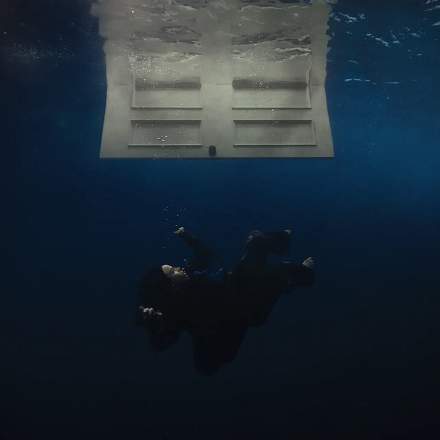
One of the characteristic qualities of a lot of Billie Eilish mixes is the way they manage to create a subjectively hard-hitting pop/EDM impression despite the essential fact that her vocal timbre is quite delicate, relying a great deal on ASMR-grade intimacy and breathiness. If you listen to a lot of her uptempo songs, you’ll hear that much of the backing is therefore actually quite dull-sounding, thereby leveraging the power of mix constrast to give the sense that Eilish’s voice is super-breathy and upfront, rather than relying on the massive injections of HF enhancement that many EDM producers fall back on. As a result, listeners can readily turn her records up loud enough to disassemble cheaper items of Ikea furniture without the mix’s upper spectrum ever getting fatiguing. Indeed, I was stood about 30 feet from the front of one of her big festival gigs last summer, and was impressed how easy her sound was on my ears compared with many of the other artists I heard from that vantage point – it was actually one of the very few shows that I felt able to listen to without earplugs!
Of course, it’s rarely possible to completely eliminate high end from your backing tracks without making the production as a whole sound muffled, and drum parts in particular often provide a kind of tonal frame of reference for the listener in this respect, so it’s interesting to hear how Eilish navigates this in her recent hit ‘Lunch’ – especially as the song helpfully ends with a couple of almost completely isolated bars of the main beat, which makes it easier to analyse! What’s particularly characteristic about this drum sound is that the brightness of each kick, snare, clap, and hi-hat is primarily concentrated right at the start of the hit. These provide a cue to the listener that the drums (and the production as a whole) have an appropriate upper-spectrum balance, but at the same time aren’t nearly as fatigung on the ear at higher playback volumes as more sustained high-frequency sounds like hissy cymbal hits or fizzy distorted guitars. In fact, if I use the outro’s isolated beat to phase-cancel those little transients out of a section of the song, it’s surprising how much overall brightness the production seems to lose. Transients In: play_arrow | get_app Transients Out: play_arrow | get_app It’s not a new trick, this, to be fair – I wrote about something similar going on in Miley Cyrus’s 'Midnight Sky' a few years back, for instance, but it nevertheless feels to me like a bit of an Eilish hallmark these days.
But there’s something else worth highlighting about this drum beat that relates to a recent Cambridge-MT patron Q&A response I wrote to the question ‘How can I fix a plodding groove?’, because this production is a classic example of a beat which very much skips along by virtue of two important programming features. Firstly, the main quarter-note beats are heavily favoured over the eighth-note off-beats in the balance – the quarter notes are both much meatier in tone and louder in the mix balance. And, secondly, the programmer has resisted the temptation to add further metric subdivisions (in this case sixteenth notes) to the programming, which is something that can quickly make a beat feel like it’s becoming more sluggish. Yes, a sixteenth-note tambourine does appear during the outro, which could have been risky, but even if this hadn’t been at a point in the song where the groove’s momentum was already well established, the tambourine’s potential for groove-dampening is also mitigated by the heavier four-to-the-floor kick pattern adding further emphasis to the main quarter-note beats at that point, and the fact that the tambourine not only appears fairly low in the mix balance again, but also itself significantly favours its eighth-note beats over the sixteenth-note subdivisions.
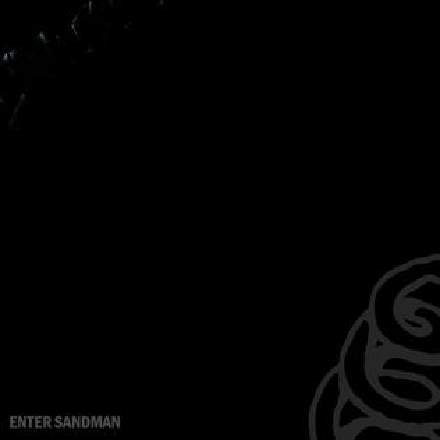
As with a lot of the best-selling albums of all time, Metallica’s Black Album has had a lot written about it. In particular, a number of pundits have asserted that one of the secrets to the band’s crossover success with this record was Lars Ulrich adapting his previous thrash-metal drumming style into a slower and simpler heavy-rock sound. But what bothers me about that assessment is that it often seems to be framed as a kind of ‘dumbing down’, whereas I think that the drum part on this particular song is tremendous. I’m no drummer, though, so this has nothing to do with an appreciation of the finer points of his performance technique – it’s all about the drum arrangement for me.
For a start, the drums provide great differentiation between the main song sections. The rumbling tom patterns of the intro (0:16-0:55), middle section (3:18-3:57), and outro (from 4:39), for instance, clearly set those sections apart from the verses, prechoruses, and choruses, while the half-time snare backbeat of the prechorus creates a clear contrast with the more traditional dual backbeats of the verses and choruses. Ulrich’s definition of the section boundaries is also very effective. Notice those lovely long eighth-note ramp-ups into the main riff (at 0:51) and final chorus (3:53), for example, as well as the shorter ones at the ends of the prechoruses (1:32, 2:24, and 3:03); or the rest bar that punctuates the end of each chorus under the line “off to Never Never Land” (1:45, 2:37, and 3:16). There are some lovely musical fills too, such as at 3:40 where two eighth-note tom rolls are followed by a backbeat snare/cymbal accent, or at 3:44 and 3:48 where other off-beat snare/cymbal accents are slotted nicely between the vocal phrases.
However, there’s one specific aspect of the drum part that I really love, and that’s the way Ulrich has taken the main guitar riff’s characteristic anticipated downbeat, and comprehensively woven that idea into the fabric of song’s rhythm. On the most basic level, the idea of the drums ‘pushing’ the downbeat of a bar (as you can hear the drums and guitars doing together for the first time when the riff first comes in at 0:54) is a great way to add urgency to any rock track – almost like the drummer is straining at the leash to rush ahead of the rest of the band! So the fact that this production features dozens of such pushed downbeats already provides a tremendous sense of energy and aggression. But rather than being merely a surface device, these pushes actually serve a profound structural purpose too, because although the riff, verse, and prechorus sections all have pushed downbeats, crucially the choruses don’t, which I think gives them a fabulous extra sense of weight and ‘arrival’.
But that’s not all, because the off-beat snare/cymbal accents also fulfil both short-term and long-term musical functions, in my opinion. On the micro-level, they deliver the same sense of rhythmic agitation that the kick-drum section-downbeat pushes do, but are sprinkled around much more liberally in all sorts of other metric locations to keep catching you by surprise – especially during the intro and outro sections. There’s also a cool kind of tug-of-war going on throughout the whole song between the off-beat and on-beat snares. Notice that the intro has only pushed snares, whereas the subsequent riff, verse, and prechorus sections (0:55-1:34) only have on-beat snares, but then the chorus combines both on-beat and off-beat snares. I also love the way that the middle section returns to the off-beat snares of the introduction, but that there’s a single on-beat snare smuggled in at 3:42 to help draw attention to the change from a spoken to a sung vocal texture at that point. And, in a sense, this forms the midway point of a long-term development from the intro, with its exclusively off-beat snares, to the outro’s more liberal intermingling of on-beat and off-beat snares.
But, of course, no discussion of the pushes in this song would be complete without praising one of the song’s best production hooks: the surprise return of the drums and main riff with the snare/cymbal off-beat accent at 4:27. There are plenty of songs where this stunt might have just sounded like a cheap gimmick, but the fact that it’s clearly cut from the same cloth as all the other off-beat accents makes it seem much more powerful and considered – notwithstanding James Hetfield’s borderline-comic “boo!”

Mainstream mix engineers often spend a great deal of time and effort trying to ensure the best possible lyric intelligibility for their lead vocal parts, but the unnecessarily poor diction of some artists really doesn’t make that job any easier – I’m thinking of songs like Bon Iver’s 'Calgary', Saint Jhn’s 'Roses (Imanbek Remix)', or Ariana Grande’s 'No Tears Left To Cry'. However, there are some situations where diction problems are caused by the nature of the melodic writing, as in this song.
The bit I’m referring to is the vocal’s title hook, which, let’s be honest, would be really difficult to decipher by ear if you didn’t already know what it was supposed to be. But it’s not because Roan’s diction in general is sloppy – I think it’s simply because the line moves into such a high register, and that makes it trickier to manage the physical mechanics of clear enunciation without cracking the notes. On the whole, notes pitched towards the upper extremes of a singer’s range involve a delicate balance of breath support and vocal control, and it’s therefore not easy to cleanly alternate such notes with the complex dynamic physiological changes and breath-stream interruptions of consonants.
In addition, high head-voice notes like these tend to be heavy on fundamental frequency and short on upper harmonics, which causes a second intelligibility problem. You see, we differentiate between vowel sounds on the basis of their characteristic patterns of upper-midrange vocal-tract resonances (the so-called ‘vocal formants’), but these resonances become less and less apparent the less frequency energy the vocal is generating in that spectral zone. So when high-register notes become mostly fundamental frequency, the vowel sounds start blurring together into various shades of ‘oo’ and ’er’.
But, while all this means that I don’t entirely blame Roan for the poor lyric intelligibility under the circumstances, I’d also say that she didn’t need to be defeatist about it either. She could, for example, have had one of the call-and-response backing vocals in a lower register to clarify the words – that would have been a fairly simple sticking plaster. Or she could have done what Sabrina Carpenter cannily did in her widely praised cover version, namely sing the first chorus down the octave, giving better intelligibility and also leaving more room for arrangement development.
Another thing that really caught my attention was the outro’s gradual tempo/pitch fall-off, which is another of those quirky production hooks that it looks like we’re increasingly going to need as humans to differentiate our work from the output of AI music generators, particularly with songs based around four-bar sections and unimaginative one-chord-per-bar chord patterns – such as the IV-V-I-vi that underlies two thirds of this song, for instance. On the face of it, the combined tempo reduction and pitch drop might sound like a simple ’tape slow-down’ effect, but what’s interesting about it is that the tempo and pitch changes aren’t actually linked in that way – by my reckoning, you’d get a pitch-drop of about a tritone if you tried to slow down the tempo that much on tape (or indeed on an old-style sampler), rather than the half-step pitch-drop on display here. So clearly the tempo and pitch changes were deliberately implemented separately, which, thinking about it, kind of makes sense, because a tritone drop in Roan’s vocal formants would have made her sound more like Cher with an epic hangover! Exhibit A: play_arrow | get_app

It’s rare enough for chart songs these days to change key at all, and the few songs that do tend to fall into one of two buckets:
- Songs with a Trucker’s Gear Shift (ie. a typically cheesy step-up modulation for the final choruses)
- Songs with some recurring section in different key – as in Lady Gaga’s ‘Paparazzi’, for instance, with its verses in C minor and choruses in Ab major.
With that in mind, this Sabrina Carpenter song is a genuine breath of fresh air, delivering a modulation stunt I’m not sure I’ve ever heard in the charts before: putting the first verse (at 0:18) and second verse (at 1:29) into different keys – the former in A major and the latter in C major. And, like all the greatest production decisions, its effectiveness seems somehow obvious with the benefit of hindsight, because the key change re-engages our attention for the arrival of a musical section that we’d normally have, to an extent, taken for granted. We’ve already heard the verse’s musical material first time round, after all, so hearing it again in the same key wouldn’t have been much of a shock, and anyone steeped in pop-structure convention (as most modern listeners are) would also understandably be expecting that material to recur pretty much unchanged after the first chorus. By changing the key of the second verse, the music rouses us listeners from our complacency with a jolt of novelty, but without any risk of rendering the verse’s underlying musical content less memorable. A poptastic win-win, in other words!
The success of any modulation, though, depends on how you get back and forth to the new key, and here too this song scores highly. Given that the modulation is meant to be an attention-grabbing feature, it makes sense that the songwriters have chosen to jump without warning into a comparatively remote key. Let me explain what I mean by this. Notice that the final chord of the first chorus is an E dominant chord, a chord which has thus far in the song always resolved traditionally in a perfect cadence back to the A tonic chord at the start of each new eight-bar section – ie. four times in total. So when the second verse’s initial C chord frustrates this well-prepared expectation, it naturally surprises the ear, because there’s been no kind of ‘warning’ preamble moving towards C major to get us ready for that chord, and neither does the C chord exist within the verse’s key of A major (the closest thing in A major would be a C# chord, which only shares one note with C major). In addition, there’s a three-sharp difference between the key signatures of the chorus (in A major, with three sharps) and the second verse (in C major, with none) – which is what I mean by the keys being ‘comparatively remote’ from each other.
For the return to the chorus, though, the idea of shocking the listener becomes a little less musically appropriate, in my opinion. The chorus is the musical ‘home plate’ of the song, so I think it stands to reason that you’d want there to be a little more harmonic logic underpinning our arrival there. Which is why it’s quite canny that the dominant G7 chord at the end of the second verse does actually resolve relatively smoothly into the opening A chord of the following chorus. Granted, it doesn’t resolve to a C chord to deliver the perfect cadence we’d most strongly expect, but the dissonant diminished-fifth interval between its leading-note B and seventh F does still resolve inwards (the B rising to C# and the F falling to E) in a similar manner that’s perfectly acceptable within the conventions of traditional harmonic theory, which gives the progression a certain harmonic logic.
Furthermore, it’s worth pointing out that this second-verse modulation doesn’t occur in a vacuum either, because the verse has a whiff of key change to it too, with the VI-ii motion in the second and third bars of the verse progression sounding an awful lot like a perfect cadence into B minor, albeit only briefly before the following D pivot chord takes us back into A major a few bars later.
All this good stuff notwithstanding, I do have a couple of harmonic niggles with the vocal arrangement during the outro section (from 2:23), because it feels like it’s working rather at odds with the song’s underlying chord progressions there. The first moment is at 2:31, where the lead vocal holds an A against the underlying chord of C#, which for me undermines the powerful harmonic momentum of this chromatically altered mediant chord. Either a G# or a B would have been a better choice there, I’d say. (Thankfully, she sings a much more appropriate E#-C#-B-E# figure when the chord returns at 2:39.) And my second quibble is with the clearly audible backing-vocal F# note that weakens the song’s closing IV-iv-I progression by clashing with the backing-track iv chord’s minor third. I’d have either melodyned that vocal F# down to an F, or I’d have removed any shadow of the F# from the backing track to make the ending a simple IV-I cadence – whereas currently it sounds like it’s falling between two stools to me.

Once I’d overcome my disappointment that this song wasn’t Swift’s hot take on Epic’s classic first-person battle-royale shooter, my first impression was honestly something along the lines of ‘is that it?’. It’s not that I dislike the song, but there just seems to be very little going on: basically just vocals, the simplest of electro kick-snare-kick-snare beats, and a plodding eighth-note bass-synth riff that repeats every eight bars – give or take some ambient atmospherics and a few one-shot fills. Listening more closely, though, and skipping around in the timeline to compare different song sections directly, there’s a lot of lovely nuanced layering and background detail (the gently pulsing synth fill on the left-hand side at 1:11, for instance, or the growling riser at 1:41) to appreciate once the basics have lost their novelty, and the texture does build tastefully to provide momentum through the song’s full duration – I particularly liked the brighter snare layer and hint of hi-hat that creeps in at the start of the second chorus (1:43), for example.
However, there’s something else that I think helps keep this song engaging: the bass riff’s syncopations, which give a kind of corresponding ’limp’ to the harmonic rhythm, given the part’s prominence in the song’s arrangement. The F# at the start of bars two and six is pushed by an eighth-note, for instance, whereas the B that begins bar seven is pulled by an eighth-note instead, and then the following G#m is pushed even further – a full quarter-note ahead of the bar-line. Now, in purely musical terms, this is the kind of thing that plenty of songwriters would instinctively blanche at, because it effectively destabilises the musical pulse by pitting the bass’s harmonic boundaries against the drums’ implied metric boundaries in a rather off-balance kind of way. It’s not the syncopations in principle that are unusual here, but just that they have such an irregular pattern – unlike, say, the much more common simple alternating pushes of things like Billie Eilish’s 'Everything I Wanted', Ed Sheeran’s 'Thinking Out Loud', Nirvana’s 'Smells Like Teen Spirit', Otis Redding’s '(Sittin' On) The Dock Of The Bay', and Tracey Chapman’s ‘Fast Car’, to name just a few famous examples. Again, though, I’m not dissing Swift for this, by any means – on the contrary, I actually think the unsettling effect of the slightly dysfunctional harmonic rhythm deftly amplifies the lyric’s depiction of a cheery suburban facade perched precariously on foundations of unresolved interpersonal tensions.
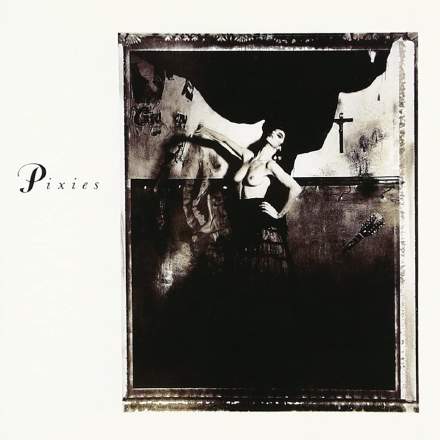
Following the sad news of Steve Albini’s death, I found myself returning wistfully to his seminal early production of the Pixies’ album Surfer Rosa. What I hadn’t realised until recently, though, was that this song was actually recorded and mixed a second time by producer Gil Norton as a radio single at the behest of the record label – and it’s fascinating to compare the two versions, because the two men’s visions for the record are so very different. (You can hear Norton’s version on the Wave Of Mutilation compilation.)
With Albini’s album version, we’re clearly getting something much more rock-oriented, with huge, weighty kick and snare sounds, thick and abrasive guitars, and a comparatively tucked-in vocal to avoid undermining the illusion of power from the band. Although Albini has something of a reputation for using plenty of room sound on drums, I get the sense that the kick and snare are both quite tightly controlled in terms of sustain, which means that the close-mic signals can keep the main beats sounding tight and punchy nonetheless. The fairly low snare tuning is another key factor here, giving the backbeat real power and drive, and its comparative stature is only helped by contrast with the restrained and fairly distant-sounding hi-hats and cymbals.
Gil Norton’s sound, on the other hand, feels rather lightweight by comparison, with a higher-pitched snare; less low end on the kick, bass, and guitars; and more of an emphasis on the hi-hat and cymbals – and I’m not sure the louder hi-hat flatters the prechorus texture either, as its slightly fussy figurations at that level feel like they’re bogging down the groove to my ears. It’s also very clear that Norton is aiming for a more mainstream ‘radio-friendly’ sound with his more homogeneous layered guitar and backing-vocal textures during the choruses, the more upfront and stereo-widened lead vocal sound, and the strong midrange presence given to the bass line’s melodic riff.
Now, it would be easy to dismiss Norton’s vision as robbing the band of power and sacrificing some of their emotional authenticity in pursuit of production polish. But if you compare the two mixes under the kinds of bandwidth-restricted and broadcast-limited playback conditions that most radio listeners experienced in the late 80s, I reckon that the dense and controlled midrange texture of Norton’s mix delivers the main musical material of the song more strongly and retains a better illusion of power than Albini’s. So it’s a definite case of horses for courses.
Not that I don’t have a few unanswered questions about both productions. Why has Albini chosen to pan Kim Deal’s lead vocal off to the right? Why does Norton have her so much quieter in the first verse than in the second? And why are both mixes rather narrow-sounding? With Albini, it seems like a wasted opportunity when mono-compatibility wouldn’t surely have been a huge concern; and with Norton, I’d have thought a wider stereo spread for some of the guitar layers would have played well with headphone listeners, especially if he’d used that added width to add extra arrangement drama for the choruses.
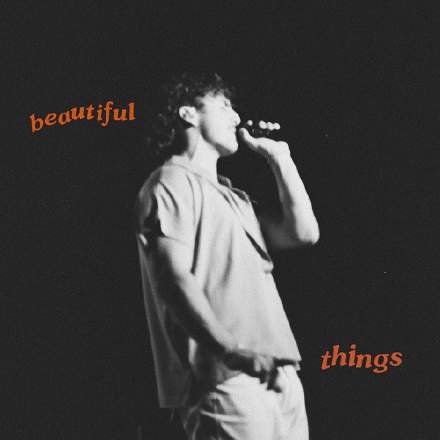
In traditional music theory, your harmony is considered diatonic if it uses only the notes of the key it’s in, and there are plenty of great songs based around entirely diatonic progressions. However, once your song sets up an expectation of diatonic harmony, it gives you the opportunity to provoke an emotional reaction from the listener at any moment by introducing a chromatic chord – in other words, any chord containing one or more notes from outside the established key. The difficulty with using chromatic chords within traditional diatonic progressions, though, is that they can easily sound a bit awkward, as if you’ve just plonked down some random chord without any sense of trying to create a harmonic logic through the progression. And this particular Benson Boone song nicely demonstrates one of the most common solutions to that problem: a secondary dominant chord.
Here’s how it works. You choose any diatonic chord other than the key’s tonic chord, and then do a V-I perfect cadence to that chord as if it were the tonic chord (of a different key). So, in this song, for instance, the opening verse section from 0:07 to 0:33 (“For a while there it was tough… I think I might have it all”) is based around a simple repeated diatonic chord progression of IV-I-V-vi-IV-I-V. But the following section (“And I thank God every day… He can take away” at 0:34-0:47) introduces a secondary dominant chord of D major, creating a fleeting perfect cadence to that pattern’s Gm chord, the vi in the progression – giving us, in the process, a nicely evocative chromatic F# note that lends extra emotional weight to the words “the girl He sent my way”. Furthermore, the juiciness of this chord has been further intensified by embellishing it with the diatonic seventh and flattened-ninth notes of C and Eb, lending the chord a strong diminished-seventh flavour, given that the root D note only appears in the lead vocal.
Now if you’re wondering whether I should instead be calling this an F# diminished chord (with an anticipatory vocal D note) rather than a first-inversion D flattened-ninth chord, you’re not alone – it’s a topic I’ve seen classical harmony teachers get quite worked up about on both sides of the debate. As you can probably tell, I’m more in the ‘flattened-ninth’ camp, because it seems to make more sense musically in terms of the voice-leading (ie. where the individual notes in the chord progress to) – I’d expect the major third of a dominant major chord to rise, and its flattened ninth to fall, as they do in this instance, so irrespective of how much it looks like a diminished seventh, I think it functions more like a dominant chord. Let’s be honest, though – these are a pretty wafer-thin distinctions in practice, so I’m not about to unfriend anyone over it! As far as I’m concerned, the most important thing with any music theory is that it’s useful for your music-making, so if you get best use out of this kind of chord by thinking of it as a diminished seventh, then that’s definitely how you should think about it – whatever my thoughts on the subject!










